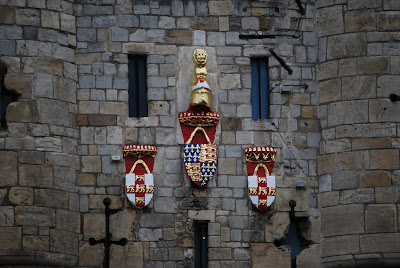In comparison to the interior (City-side) of Micklegate Bar in York, England, the exterior (outward-facing) side of the Bar is much more highly-decorated with heraldry, in addition to the dramatic turrets and battlements and narrow windows and arrow slits.
Most noticeable, of course, are the Royal Arms of England as used from the time of King Edward III until King Henry IV reduced the number of fleurs-de-lis in the French quarters from many to three. Quarterly: 1 and 4, Azure semy-de-lis or; 2 and 3, Gules three lions passant guardant in pale or.
The Royal Arms, shown here hanging from the shield's guige, or strap, painted gold, are surmounted by a great helm atop which, issuant from a cap of maintenance, is a lion statant affronty.
The Royal Arms are flanked by two representations of the arms of the City of York: Argent on a cross gules five lions passant guardant or. Here, too, the shields are shown hanging by their golden guiges.
You may wish to click on the image above to see a larger, more detailed image of these shields.
And finally, immediately above the central arch of the Bar, is another shield, this one couched (displayed at an angle instead of upright), but also hanging from its guige:
The arms are those of Sir John Lister-Kaye, 1st Baronet (1772-1827), a noted English amateur cricketer in the late 18th century. An illegitimate son of a baronet, he was created a baronet in his own right in December 1812 when he inherited the Lister estates by will. Sir John's acquisition of the landed estates devised on him was the cause for entitlement for a baronetcy, when George III created a new title by patent on 28 December 1812. His land included the Manors of Burton (or Kirkburton), Woodsham, Shelley and other lands in Yorkshire.
Sir John's arms are blazoned: Quarterly: 1 and 4, Argent two bendlets sable (Kaye); 2 and 3, Ermine on a fess sable three mullets or (Lister); overall on an escutcheon, Argent a sinister hand couped appaumy gules. (The small escutcheon on the shield is, of course, the armorial insignia of a baronet.)
The date inscribed below the shield is incorrect; it should have another "C" in it. Micklegate Bar was renovated in 1827, not 1727.
Sir John's arms have been placed on the face of the Bar because before his death in 1827 he was Lord Mayor of York.
All in all, the arms on Micklegate Bar, the main gate into the City of York, make an impressive display for anyone riding up to the city, whatever their intentions (peaceful or otherwise) might have been.













No comments:
Post a Comment